欧洲中世纪文学【英文精品】共41页
- 格式:ppt
- 大小:4.31 MB
- 文档页数:41
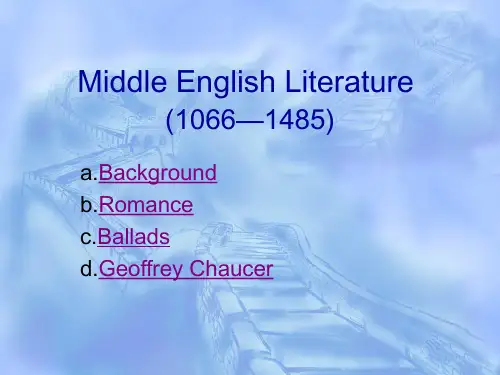

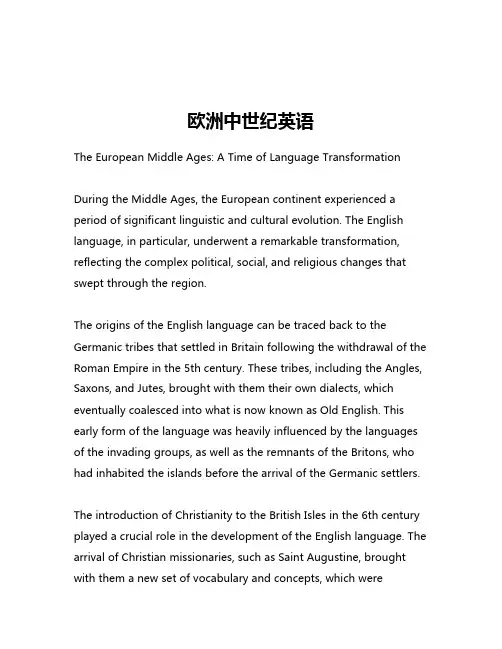
欧洲中世纪英语The European Middle Ages: A Time of Language TransformationDuring the Middle Ages, the European continent experienced a period of significant linguistic and cultural evolution. The English language, in particular, underwent a remarkable transformation, reflecting the complex political, social, and religious changes that swept through the region.The origins of the English language can be traced back to the Germanic tribes that settled in Britain following the withdrawal of the Roman Empire in the 5th century. These tribes, including the Angles, Saxons, and Jutes, brought with them their own dialects, which eventually coalesced into what is now known as Old English. This early form of the language was heavily influenced by the languages of the invading groups, as well as the remnants of the Britons, who had inhabited the islands before the arrival of the Germanic settlers.The introduction of Christianity to the British Isles in the 6th century played a crucial role in the development of the English language. The arrival of Christian missionaries, such as Saint Augustine, brought with them a new set of vocabulary and concepts, which weregradually incorporated into the existing linguistic framework. This influx of religious terminology, coupled with the increasing use of Latin in ecclesiastical and scholarly circles, helped to shape the evolution of Old English.As the centuries passed, the English language continued to evolve, reflecting the dynamic political and social landscape of the European Middle Ages. The Norman Conquest of 1066, led by William the Conqueror, had a profound impact on the language. The influx of French vocabulary and grammatical structures into the English language, as a result of the Norman influence, led to the development of Middle English.Middle English, which was spoken from the 11th to the 15th century, was a complex and diverse linguistic form, with regional dialects and variations. This period saw the emergence of some of the most renowned literary works in the English language, such as Geoffrey Chaucer's "The Canterbury Tales," which showcased the richness and versatility of the language.During the Middle Ages, the English language also played a crucial role in the dissemination of knowledge and the preservation of cultural heritage. The translation of religious texts, such as the Bible, into the vernacular languages, including English, helped to make these important works accessible to a wider audience. Additionally,the development of educational institutions, such as universities, contributed to the standardization and codification of the language, as scholars and scribes worked to establish a more uniform system of grammar and orthography.Moreover, the Middle Ages witnessed the emergence of a vibrant literary tradition in the English language. Writers and poets, such as William Langland and the anonymous author of "Beowulf," explored a wide range of themes, from religious devotion to heroic tales, using the evolving language as a powerful tool of expression.The linguistic diversity and dynamism of the European Middle Ages were not limited to the English language alone. Other languages, such as French, German, and Italian, also underwent significant transformations during this period, reflecting the broader cultural and political changes that swept through the continent.In conclusion, the European Middle Ages were a formative era in the evolution of the English language. The complex interplay of political, social, and religious forces, combined with the influx of foreign linguistic influences, contributed to the remarkable transformation of the language, laying the foundation for its eventual rise as a global lingua franca. The rich literary and cultural heritage of this period continues to shape our understanding of the English language and its enduring significance in the context of European history.。
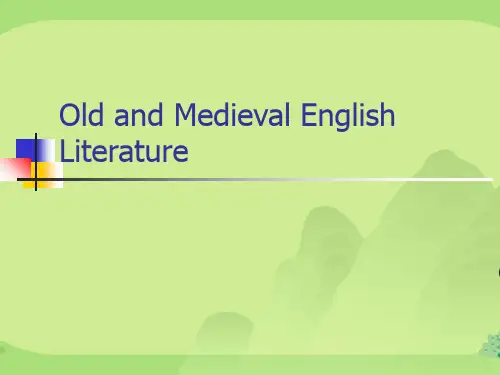
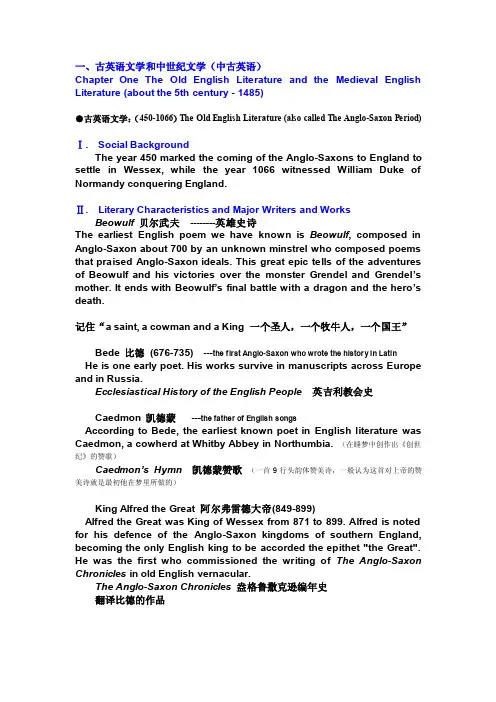
一、古英语文学和中世纪文学(中古英语)Chapter One The Old English Literature and the Medieval English Literature (about the 5th century - 1485)●古英语文学:(450-1066)The Old English Literature (also called The Anglo-Saxon Period)Ⅰ. Social BackgroundThe year 450 marked the coming of the Anglo-Saxons to England to settle in Wessex, while the year 1066 witnessed William Duke of Normandy conquering England.Ⅱ. Literary Characteristics and Major Writers and WorksBeowulf 贝尔武夫--------英雄史诗The earliest English poem we have known is Beowulf, composed in Anglo-Saxon about 700 by an unknown minstrel who composed poems that praised Anglo-Saxon ideals. This great epic tells of the adventures of Beowulf and his victories over the monster Grendel and Grendel’s mother. It ends with Beowulf’s final battle with a dragon and the hero’s death.记住“a saint, a cowman and a King 一个圣人,一个牧牛人,一个国王”Bede 比德(676-735) ---the first Anglo-Saxon who wrote the history in LatinHe is one early poet. His works survive in manuscripts across Europe and in Russia.Ecclesiastical History of the English People 英吉利教会史Caedmon 凯德蒙---the father of English songsAccording to Bede, the earliest known poet in English literature was Caedmon, a cowherd at Whitby Abbey in Northumbia. (在睡梦中创作出《创世纪》的赞歌)Caedmon’s Hymn 凯德蒙赞歌(一首9行头韵体赞美诗,一般认为这首对上帝的赞美诗就是最初他在梦里所做的)King Alfred the Great 阿尔弗雷德大帝(849-899)Alfred the Great was King of Wessex from 871 to 899. Alfred is noted for his defence of the Anglo-Saxon kingdoms of southern England, becoming the only English king to be accorded the epithet "the Great". He was the first who commissioned the writing of The Anglo-Saxon Chronicles in old English vernacular.The Anglo-Saxon Chronicles 盎格鲁撒克逊编年史翻译比德的作品●中世纪文学:(1066-1485)The Medieval English LiteratureⅠ. Social BackgroundMiddle English literature refers to the literature in the period from Norman Conquest to the end of the Wars of the Roses and the accession of Henry Ⅶ. The evolution of something new is most apparent in some of the developments in religious writing in Middle English literature. The literature was various and deeply influenced by French.Ⅱ. Literary Characteristics and Major Writers and WorksTwo main literature forms:Medieval Romance (浪漫传奇:原本指中世纪早期地中海沿岸西部地区的一种用诺曼语讲述的故事。
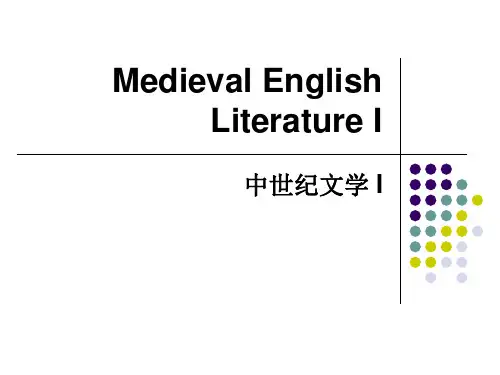
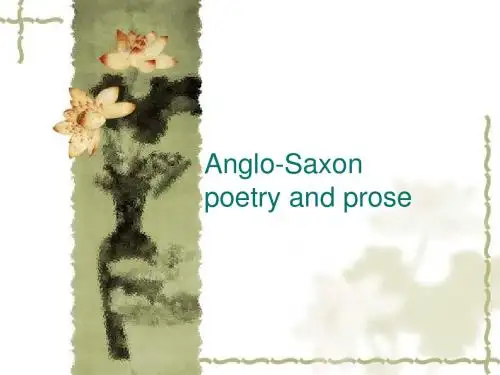

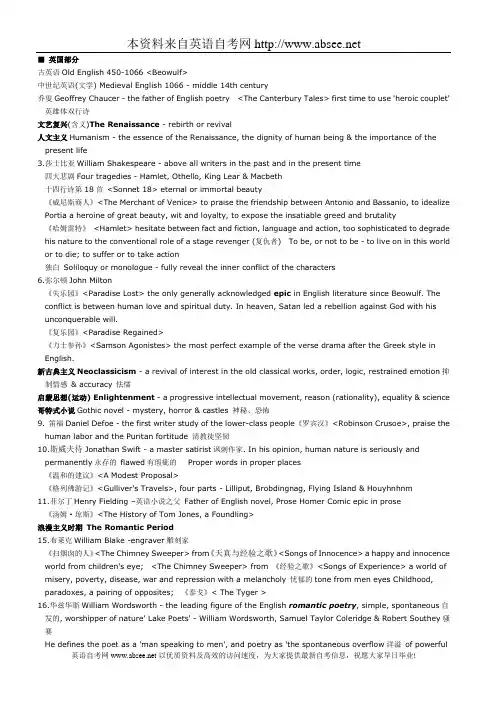
■英国部分古英语Old English 450-1066 <Beowulf>中世纪英语(文学) Medieval English 1066 - middle 14th century乔叟Geoffrey Chaucer - the father of English poetry <The Canterbury Tales> first time to use 'heroic couplet' 英雄体双行诗文艺复兴(含义)The Renaissance - rebirth or revival人文主义Humanism - the essence of the Renaissance, the dignity of human being & the importance of the present life3.莎士比亚William Shakespeare - above all writers in the past and in the present time四大悲剧Four tragedies - Hamlet, Othello, King Lear & Macbeth十四行诗第18首<Sonnet 18> eternal or immortal beauty《威尼斯商人》<The Merchant of Venice> to praise the friendship between Antonio and Bassanio, to idealize Portia a heroine of great beauty, wit and loyalty, to expose the insatiable greed and brutality《哈姆雷特》<Hamlet> hesitate between fact and fiction, language and action, too sophisticated to degrade his nature to the conventional role of a stage revenger (复仇者) To be, or not to be - to live on in this world or to die; to suffer or to take action独白Soliloquy or monologue - fully reveal the inner conflict of the characters6.弥尔顿John Milton《失乐园》<Paradise Lost> the only generally acknowledged epic in English literature since Beowulf. The conflict is between human love and spiritual duty. In heaven, Satan led a rebellion against God with his unconquerable will.《复乐园》<Paradise Regained>《力士参孙》<Samson Agonistes> the most perfect example of the verse drama after the Greek style in English.新古典主义Neoclassicism - a revival of interest in the old classical works, order, logic, restrained emotion抑制情感& accuracy 怯懦启蒙思想(运动) Enlightenment - a progressive intellectual movement, reason (rationality), equality & science 哥特式小说Gothic novel - mystery, horror & castles 神秘、恐怖9. 笛福Daniel Defoe - the first writer study of the lower-class people《罗宾汉》<Robinson Crusoe>, praise the human labor and the Puritan fortitude 清教徒坚韧10.斯威夫待Jonathan Swift - a master satirist讽刺作家. In his opinion, human nature is seriously and permanently永存的flawed有瑕疵的Proper words in proper places《温和的建议》<A Modest Proposal>《格列佛游记》<Gulliver's Travels>, four parts - Lilliput, Brobdingnag, Flying Island & Houyhnhnm11.菲尔丁Henry Fielding –英语小说之父Father of English novel, Prose Homer Comic epic in prose《汤姆·琼斯》<The History of Tom Jones, a Foundling>浪漫主义时期The Romantic Period15.布莱克William Blake -engraver雕刻家《扫烟囱的人》<The Chimney Sweeper> from《天真与经验之歌》<Songs of Innocence> a happy and innocence world from children's eye; <The Chimney Sweeper> from 《经验之歌》<Songs of Experience> a world of misery, poverty, disease, war and repression with a melancholy 忧郁的tone from men eyes Childhood, paradoxes, a pairing of opposites; 《泰戈》< The Tyger >16.华兹华斯William Wordsworth - the leading figure of the English romantic poetry, simple, spontaneous自发的, worshipper of nature' Lake Poets' - William Wordsworth, Samuel Taylor Coleridge & Robert Southey骚赛He defines the poet as a 'man speaking to men', and poetry as 'the spontaneous overflow洋溢of powerfulfeelings, which originates in 'emotion recollected沉思默想的in tranquillity安静'.“我孤独地游荡,就象一朵云”<I Wandered Lonely as a Cloud> the poet is very cheerful with recalling the beautiful sights. In the poem on the beauty of nature, the reader is presented a vivid picture of lively and lovely daffodils 水仙and poet's philosophical ideas and mystical thoughts.《威斯敏斯特桥上,1802年9月3日》<Composed upon Westminster Bridge, September 3, 1802> the sonnet describes a vivid picture of a beautiful morning in London, silent, bright, glittering, smokeless & mildly. It is so touching a sight that the poet expressed his religion piety 虔诚for nature.《?绿竹》<She Dwelt Among the Untrodden Ways>《孤独的割麦女》<The Solitary Reaper> thanks to poet's rich imagination, the mass of associations, this commonplace happening becomes a striking event, the poet succeeds in making the reader's share his emotion. The poem also shows the poet's passionate love of nature.19.雪莱Percy Bysshe Shelley?致英国人民<Men of England>《西风颂》<Ode to the West Wind> terza rima三行体, destructive-constructive potential, hopeful, 'I fall upon the thorns of life! I bleed!', 'If Winter comes, can Spring be far behind?'21.简奥斯汀Jane Austen《傲慢与偏见》<Pride and Prejudice>The Victorian Period达尔文《物种起源》Darwin's <The Origin of Species> and 《人类起源》<The Descent of Man> shook the traditional faith, everything is created by God功利主义Utilitarianism was widely accepted and practiced Critical realists were all concerned about the fate of the common people维多利亚时期The Victorian Period22.狄更斯Charles Dickens - one of the greatest critical realist writers批判现实主义作家of the Victorian Age维多利亚时代Character-portrayal描写is the most distinguishing feature特点of his works A mingling混合of humor and pathos 悲伤,惆怅《双城记》<A Tale of Two Cities> 《雾都孤儿》<Oliver Twist>23.勃朗蒂姐妹The Brontë Sisters - Charlotte, Emily & Anne Brontë, a rather reserved and simple girl, was very much a child of nature.《简·爱》<Jane Eyre> 《呼啸山庄》<Wuthering Heights>27.哈代Thomas Hardy - both a 自然主义naturalistic and a critical realist writer 地方乡土色彩Local-colored, Wessex, 'novels of character and environment'《德勃家的苔斯》<Tess of the D'Urbervilles> experience is as to intensity剧烈, and not as to duration持续?夜里的相会<Meeting at Night> ?早上的分别<Parting at Morning>现代主义The Modern Period28.萧伯纳George Bernard Shaw- 1884 join the Fabian Society, strongly against the credo信条of “art for art’s sake”, vehemently 激烈condemned the “well made” but cheap, hollow plays. He wrote more than 50 plays. Mission of his drama was to reveal the moral, political and economic truth from a radical reformist point of view.《鳏夫的房产》<Widow er’s Houses> 《康帝坦》<Candida> 《华伦夫人的职业》<Mrs. Warren’s Profession> 《恺撒和克里奥佩特拉》<Caesar and Cleopatra> 《圣女贞德》<St. Joan> 《人与超人》<Man and Superman> 《皮格马利翁》<Pygmalion> 《回到麦修色拉》<Back to Methuselah> 《苹果车》<The Apple Cart> 31. T. S.艾略特T. S. Eliot《普鲁弗洛克的情歌》<The Love Song of J.Alfred> 《荒原》<The Waste Land> 《灰星期三》<Ash Wednesday>《四个四重奏》<Four Quartets>32.劳伦斯D. H. Lawrence《儿子和情人》<Sons and Lovers> 《虹》<The Rainbow> 《恋爱中的女人》<Woman in Love>33.乔伊斯James Joyce《都柏林人》<Dubliners> 《青年艺术家的肖像》<The Portrait of The Artist As a Young Man> 《尤利西斯》<Ulysses>■美国部分Started with Washington Irving's <The Sketch Book> and ended with Whitman's <Leaves of Grass>, also called 'the American Renaissance'Free expression of emotion, escapes from society, and return to nature New England Transcendentalism 先验主义/超验主义3.霍桑Nathaniel HawthorneInterior of the heart, there is evil in every human heart, which may remain latent, perhaps, through the whole life, but circumstances may rouse it to activity<The Scarlet Letter><Young Goodman Brown>4.惠特曼Walt WhitmanOpenness, freedom, individualismI - me, my nation (society), Free verse, Envelope structure, Catalogue (Listing)A new ideal, a new world, a new life-style<There Was a Child Went Forth> how a child is greatly influenced by his growing environments<Cavalry Crossing a Ford> a scene of the American Civil War, all the movements described in this picture are frozen.<Song of Myself> Whitman is a man bubbling with energy and laden with ideas, spontaneous expression of his original ideas5.麦尔维尔Herman Melville - a master of allegory and symbolism, like Hawthorne<Moby-Dick> the first American prose epic, Ishmael both as a character and a narrator, the captain, Ahab is a monomaniac Realistic period - the Gilded Age, the poor poorer and the rich richer, people's attention was now directed to the interesting features of everyday existenceLocal colorism, social Darwinism, bestiality, beyon man's control6.马克·土温Mark Twain - the true father of American literatureLocal colorist, vernacular, simple sentence, 'the damned human race' The Gilded Age3 boyhood books <Life on the Mississippi>, <The Adventures of Tom Sawyer>, <Adventures of Huckleberry Finn><Adventures of Huckleberry Finn> Huck's inner conflict about whether or not he should write a letter to tell Miss Watson where Jim is.7.亨利詹姆斯Henry James - international theme, psychological realistStream of consciousness, interior monologue, free association<Daisy Miller> the narrator is an American expatriate, named Winterbourne. Daisy is the most innocent girl. The clash is between two different cultures.8.迪金森Emily DickinsonBased on her own experiences, her sorrows and joys<This is my letter to the World> express Dickinson's anxiety about her communication with the outside world.<I heard a Fly buzz - when I died - > description of a moment of death<I like to see it lap the Miles> Dickinson makes the train part of nature by animalizing it, like a horse.<Because I could not stop for Death - > personify death and immortality so as to make her message strongly felt9.西奥多·德莱塞Theodore Dreiser - America's literary naturalists Case history including everything Determinism (heredity biological & environment), survival of the fittest, the jungle law Trilogy of Desire - <The Financier>, <The Titan>, <The Stoic> <Sister Carrie> 'who shall cast the first stone?'The modern period - the second American Renaissance, the expatriate movement, the Lost Generation, a transformation from order to disorderSeize the day, enjoy the present, spiritual wasteland, collective unconscious, psychoanalysisImagist movement, Jazz Age11.弗洛斯特Robert Lee Frost - four times awarded Pulitzer Prize, pastoral life and scene<After Apple-Picking><The Road Not Taken><Stopping by Woods on a Snowy Evening>13.司哥特·费兹杰拉德F. Scott Fitzgerald - spokesman of the Jazz Age, Dollar Decade, 1920sA double vision of the Jazz Age, both an insider and an outsiderAmerican Dream了不起的盖茨比<The Great Gatsby>14.海明威Ernest Hemingway - awarded the Nobel PrizeIceberg style, Code hero, the lost generation, grace under pressure<Indian Camp> from <In Our Time> birth and death coexist15.福克纳·William Faulkner - awarded a Nobel PrizeSouth, imprisonment in the pastStream of consciousness, multiple points of viewYoknapatawpha Country<A Rose for Emily> Emily is regarded as the symbol of tradition and theold way of life. Thus her death is like the falling of a monument.。
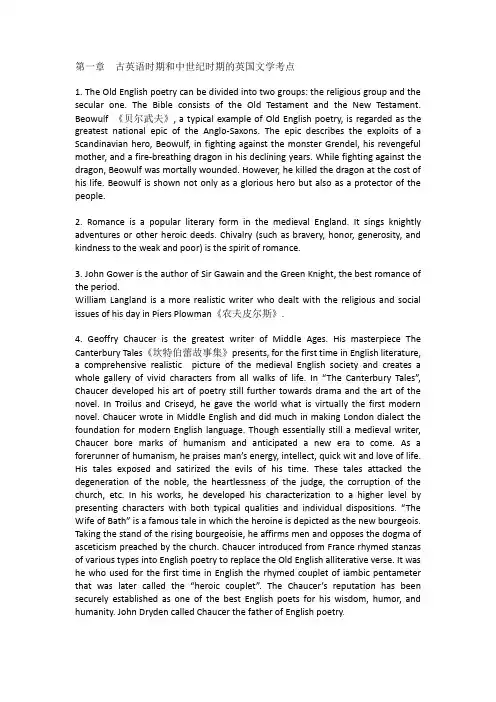
第一章古英语时期和中世纪时期的英国文学考点1. The Old English poetry can be divided into two groups: the religious group and the secular one. The Bible consists of the Old Testament and the New Testament. Beowulf 《贝尔武夫》, a typical example of Old English poetry, is regarded as the greatest national epic of the Anglo-Saxons. The epic describes the exploits of a Scandinavian hero, Beowulf, in fighting against the monster Grendel, his revengeful mother, and a fire-breathing dragon in his declining years. While fighting against the dragon, Beowulf was mortally wounded. However, he killed the dragon at the cost of his life. Beowulf is shown not only as a glorious hero but also as a protector of the people.2. Romance is a popular literary form in the medieval England. It sings knightly adventures or other heroic deeds. Chivalry (such as bravery, honor, generosity, and kindness to the weak and poor) is the spirit of romance.3. John Gower is the author of Sir Gawain and the Green Knight, the best romance of the period.William Langland is a more realistic writer who dealt with the religious and social issues of his day in Piers Plowman 《农夫皮尔斯》.4. Geoffry Chaucer is the greatest writer of Middle Ages. His masterpiece The Canterbury Tales《坎特伯蕾故事集》presents, for the first time in English literature, a comprehensive realistic picture of the medieval English society and creates a whole gallery of vivid characters from all walks of life. In ―The Canterbury Tales‖, Chaucer developed his art of poetry still further towards drama and the art of the novel. In Troilus and Criseyd, he gave the world what is virtually the first modern novel. Chaucer wrote in Middle English and did much in making London dialect the foundation for modern English language. Though essentially still a medieval writer, Chaucer bore marks of humanism and anticipated a new era to come. As a forerunner of humanism, he praises man’s energy, intellect, quick wit and love of life. His tales exposed and satirized the evils of his time. These tales attacked the degeneration of the noble, the heartlessness of the judge, the corruption of the church, etc. In his works, he developed his characterization to a higher level by presentingcharacters with both typical qualities and individual dispositions. ―The Wife of Bath‖ is a famous tale in whichthe heroine is depicted as the new bourgeois. Taking the standof the rising bourgeoisie, he affirms men and opposes the dogmaof asceticism preached by the church. Chaucer introduced from France rhymed stanzas of various types into English poetryto replace the Old English alliterative verse. It was he who used for the first time in English the rhymed couplet of iambic pentameter that was later called the ―heroic couplet‖. The Chaucer’s reputation has been securely established as one ofthe best English poets for his wisdom, humor, and humanity. John Dryden called Chaucer the father of English poetry.第二章文艺复兴时期的英国文学考点1. Renaissance refers to the transitional period from the medieval to the modern world. It first started in Italy inthe 14th century, lasting into the 17th century. The Renaissance means rebirth or revival. It was marked by a humanistic revival of ancient Roman and Greek classics expressed in a flowering of the arts and literature and bythe beginnings of modern science. Humanism is the essence ofthe Renaissance. The English Renaissance did not begin untilthe reign of Henry VI II. It was usually regarded as England’s Golden Age, especially in literature. Among the literary giants were Shakespeare, Spenser, Johnson, Sidney, Marlowe, Bacon and Donne, and John Milton was the last great poet ofthe English Renaissance. The real mainstream of the English Renaissance is the Elizabethan drama.2. Humanism is the essence of the Renaissance. It emphasizesthe dignity of human beings and the importance of the present life. Humanists voiced their beliefs that man was the centerof the universe and man did not only have the right to enjoythe beauty of the present life, but had the ability to perfect himself and to perform wonders.3. Petrarch was regarded as the fountainhead of literatureby the English writers. Wyatt introduced the Petrarchan sonnet into England. Surrey brought in blank verse(无韵体诗),i.e.the unrhymed iambic(抑扬格的)pentameter(五音步的)line.4. Renaissance drama: the Elizabethan drama is the realmainstream of the English Renaissance. English dramas were influenced by the Greek and Roman classics. Thomas Kyd wrote the earliest popular tragedy of blood and revenge, The Spanish Tragedy. The most famous dramatists in the Renaissance England are Christopher Marlowe, William Shakespeare, and Ben Johnson. Elizabethan drama reache d its peak in Shakespeare’s works. Shakespeare’s compassionate understanding of the human fate has perpetuated his greatness and made him the representative figure of English literature for the whole world. Francis Bacon was the first important English essayist. He was the founder of modern science in England. His writing paved the way for the use of scientific method.5. University Wit refers to any of a notable group of pioneer English dramatists writing during the last 15 years of the 16th century. They transformed the native dramatic inheritance of interlude and chronicle play into a potentially great drama by writing plays of quality and diversity. In doing so they prepared the ground for genius of William Shakespeare. Their forerunner was John Lily, Christopher Marlowe, Thomas Nashe, Robert Green, and Thomas Kyd, etc. All these writers except Thomas Kyd took degrees from universities like Oxford and Cambridge.6. Edmund Spenser: The Shepherd’s Calendar is his early work. Spenser’s masterpiece is the F aerie Queene 《仙后》, a great poem of its age. There are five main qualities in Spenser’s poetry: a perfect melody; a rare sense of beauty; a splendid imagination; a lofty moral purity and seriousness, and a dedicated idealism. It is Spenser’s idealism, his love of beauty, and his exquisite melody that earn him the title of ―the poets’ poet.‖ (诗人的诗人)The Faerie Queene is written in the stanza invented by Spenser himself, the Spenserian stanza, i.e., a stanza(诗的一节)of nine lines, with the first eight lines in iambic pentameter and the last line in iambic hexameter(六音步), rhyming ababbcbcc.7.Christopher Marlowe:(1) As the most gifted of the ―University Wits‖, Marlowe composed six plays within his short lifetime. Among them the most important are: Tamburlaine, Dr. Faustus, The Jew of Malta and Edward II. Tamburlaine is a play about an ambitious and pitiless Tartar conqueror in the fourteenth century who rosefrom a shepherd to an overpowering king. By depicting a great hero with high ambition and sheer brutal force in conquering one enemy after another, Morlowe voiced the supreme desire of the man of the Renaissance for infinite power and authority. Dr. Faustus is a play based on the German legend of a magician aspiring for knowledge and finally meeting his tragic end as a result of selling his soul to the Devil. It celebrates the human passion for knowledge, power and happiness; it also reveals man’s frustration in realizing the high aspirations in a hostile moral order. And the confinement to time is the cruelest fact of man’s condition. The play is a good example to illustrate the idea that a man gains the whole world but loses his own soul.(2) Marlowe’s greatest literary achievement lies in that he perfected the blank verse and made it the principal medium of English drama. He brought vitality and grandeur into the blank verse with his ―mighty lines‖ which carry strong emotions. Marlowe’s second achievement is his creation of the Renaissance hero for English drama. Such hero is always individualistic and full of ambition, facing bravely the challenge from both gods and men. Such a hero embodies Marlowe’s humanistic ideal of human dignity and capacity. With the endless aspiration for power, knowledge, and glory, the hero embodies the true Renaissance spirit.8. William Shakespeare (1564—1616):(1) Shakespeare was born on April 23, 1564, into a merchant’s family in Stratford-on-Avon. In 1582, he got married and had three children. It was probably because he had to support his growing family that he left for London. Shakespeare wrote 38 plays, 154 sonnets and 2 long poems. He is the greatest dramatist of the English Renaissance. Shakespeare is above all writers in the past and in the present time. Robert Greene, one of the ―University Wits‖, resentfully declared him to be ―an upstart crow.‖ He died on April 23, 1616. Shakespeare is surpassingly great because his works never fail to bear a kind of closeness to human life and never fail to be the mirror reflecting human nature. Shakespeare is so great that maybe only Ben Johnson’s praising poem will somewhat cover his greatness: ―…Soul of the Age! The applause! delight! The wonder of our stage! Triumph, my Britain, thou hast one to show To whom all scenes of Europe homage owe. He was not of an age, but for all time!‖(2) Shakesp eare’s four dramatic periods:a. His first dramatic period was one of apprenticeship. He wrote five history plays: Henry VI, Parts I, II, and III, Richard III, and Titus Andronicus; and four comedies: The Comedy of Errors, The Two Gentlemen of Verona, The Taming of the Shrew, and Love’s Labour’s Lost.b. His second dramatic period was highly individualized. He wrote five history plays: Richard II, King John, Henry IV, Parts I and II, and Henry V; six comedies: A Midsummer Night’s Dream, The Merchant of Venice, Much Ado About Nothing, As You Like It, Twelfth Night, and The Merry Wives of Windsor; and two tragedies: Romeo and Juliet and Julius Caesar. Romeo and Juliet eulogizes the faithfulness of love and the spirit of pursuing happiness. The play, though a tragedy, is permeated with optimistic spirit. Shakespeare’s history plays of these two periods are mainly written under the principle that national unity under a mighty and just sovereign is a necessity.c. His third period includes his greatest tragedies and his so-called dark comedies. The tragedies of this period are: Hamlet, Othello, King Lear, Macbeth, Antony and Cleopatra, Troilus and Cressida, and Coriolanus. The two comedies are: All’s Well That Ends Well and Measure for Measure. Hamlet, Othello, King Lear, and Macbeth are Shakespeare’s four greatest tragedies. They have some characteristics in common. Each tragedy portrays a noble hero, who faces the injustice of human life and is caught in a difficult situation and whose fate is closely connected with the fate of the whole nation. Each hero has his weakness of nature: Hamlet, the melancholic scholar-prince, faces the dilemma between action and mind; Othello’s inner weakness is made use of by the outside evil force; the old King Lear who is unwilling to totally give up his power makes himself suffer from treachery and infidelity. In King Lear, Shakespeare has not only made a profound analysis of the social crisis in which the evils can be seen everywhere, but also criticized the bourgeois egoism; an d Macbeth’s lust for power stirs ups his ambition and leads him to incessant crimes. In these tragedies Shakespeare portrays the weakness of each hero and shows the conflict between the individual and the evil force in the society.d. Shakespeare’s last p eriod includes romantic tragicomedies: Pericles,Cymbeline, The Winter’s Tale, The Tempest, Henry VIII and The Two Noble Kinsmen. The Tempest is the best ofhis final romances. It typically shows Shakespeare’s pessimistic views towards human life and society in his late years.e. Shakespeare’s non-dramatic poetry consists of two long narrative poems: Venus and Adonis and The Rape of Lucrece,and 154 sonnets. Shakespeare’s sonnets are the only direct expression of the poet’s own feelings. His sonnets numbered 1-126 are addressed to a young man, Shakespea re’s beloved friend. The sonnets numbered 127-152 involve a mistress of Shakespeare, a mysterious ―Dark Lady‖. His sonnets’ most common themes concern the destructive effects of time, the quickness of physical decay, and the loss of beauty, vigor, and love. Sonnet 18 is one of Shakespeare’s most beautiful sonnets. In the poem he has a profound meditation on the destructive power of time and the eternal beauty brought forth by poetry to the one he loves. A nice summer’s day is usually transient, but the beauty in poetry can last for ever. Thus Shakespeare has a faith in the permanence of poetry. The rhyme of the poem is abab cdcd efef gg.(3) Shakespeare’s literary ideas:As a humanist writer, Shakespeare has accepted the Renaissance views on literature. He holds that literature should be a combination of beauty, kindness and truth, and should reflect nature and reality. He claims through the mouth of Hamlet that the ―end‖ of dramatic creation is to give faithful reflection of the social realities of the time. He also says that literary works which have truly reflected nature and reality can reach immortality.(4) The Merchant of Venice:The play has a double plot: an impoverished young man, Bassanio asks his friend, Antonio, for a loan so that he might marry Portia, a rich and beautiful heiress of Belmont. They fall in love with each other at first sight. Bassanio passes the test of the caskets and he chooses the right one containing Portia’s portrait. However, their rejoicing is interrupted by a letter fro m Antonio; Antonio’s money is all invested in mercantile expeditions. He has to borrow money from Shylock, the Jewish usurer. Shylock has made a strange bond requiring Antonio to surrender a pound of his flesh if he fails to repay him within a certain peri od of time. Antonio’s letter reads that his ships are lost at sea, and he is penniless, and will have to pay the pound of flesh. The most famous part of thecomedy is Act IV, Scene I. It is the major climax of the play. It takes place in a court of law at which Portia appears disguised as a young lawyer instructed to judge the case. She first appeals to Shylock to have mercy. But when he insists on the letter of the law, she lets him have it. He may take his pound of flesh, but there is no mention of blood in the bond; if he sheds a single drop of a Christian’s blood, his lands and goods will be confiscated by the State according to the law of Venice. Thus Antonio is saved, and Shylock has to undergo certain severe penalties, including compulsory conversion to Christianity. The traditional theme of the play is to praise the friendship between Antonio and Bassanio, to idealize Portia as a heroine of great beauty, wit and loyalty, and to expose the Insatiable greed and brutality of the Jew. But people today tend to regard the play as a satire of the Christian’s hypocrisy and their false standards, their cunning ways of pursuing worldliness and their unreasoning prejudice against Jews.(5) HamletHamlet is considered the greatest of Shakespeare’s tragedies. It has the qualities of a ―blood-and-thunder‖ thriller and a philosophical exploration of life and death. Shakespeare takes the bare outlines of Revenge Tragedy used in Thomas Kyd in his The Spanish Tragedy. The timeless appeal of Hamlet lies in its combination of intrigue, emotional conflict and searching philosophic melancholy. In the play Hamlet is urged by the ghost of his father (who is murdered by Claudius) to seek revenge. Hamlet hesitates in his revenge not because he is incapable of action, but because the cast of his mind is so speculative, so questioning, and so contemplative that action, when it finally comes, seems almost like defeat, diminishing rather than adding to the stature of the hero. He lives suspended between fact and fiction, language and action. For Hamlet, soliloquy is a natural medium,a necessary release of his anguish. ―To be or not to be‖ soliloquy is the best known and often felt to be central to Hamlet’s personality. It provides an excellent example of Hamlet not doing anything. In his case we can conclude that too much thinking makes action impossible. The play is also Shakespeare’s most detailed expose of a corrupted court----―an unweeded garden‖ in which there is nothing but ―a foul and pestilent congregation of vapours‖(汇集着各种罪恶肮脏的气体).(6) MacbethMacbeth is one of Shakespeare’s four greatest tragedies. He is introduced in the play as a warrior hero, whose fame on the battlefield wins him great honor from the king. His physical courage is joined by a consuming ambition and a tendency to self-doubt----the prediction that he will be king brings him joy, but it also creates inner turmoil. These three attributes----bravery, ambition, and self-doubt----struggle for mastery of Macbeth throughout the play. Shakespeare uses Macbeth to show the terrible effects that ambition and guilt can have on a man who lacks strength of character.(7) King LearLear’s basic flaw at the beginning of the play is that he values appearances above reality. He wants to be treated as a king and to enjoy the title, but he doesn’t want to fulfill a king’s obligations of governing for the good of his subjects. Similarly, his test of his daughters demonstrates that he values a flattering public display of love over real love. But his values do change over the course of the play. As he realizes his weakness and insignificance in comparison to the awesome forces of the natural world, he becomes a humble and caring individual. Eventually, Lear displays regret, remorse, empathy, and compassion for the poor, a population that Lear has not noticed before. He comes to cherish Cordelia above everything else and to place his own love for Cordelia above every other consideration, to the point that he would rather live in prison with her than rule as a king again. King Lear’s madness: The madness in King Lear enables him to realize the essence of a corrupt society, in which each is ready to destroy the other. He not only sympathizes with the poor but realizes for the first time with much remorse for his former tyranny and indifference toward the suffering multitude. The madness is also the course of Lear’s spiritual pilgrimage from arrogance into humiliation, misery, and finally a rebirth into a childlike simplicity and humility. Moreover, King Lear also presents Shakespeare’s affirmation of national unity and royal responsibility. Shakespeare seems to point out that the king, however great he might be, should be responsible to the people. If, in one way or another, he betrays the people’s trust, history will condemn him. It is just at this point, when he seems to have earned an innocent happiness, that his tragic suffering culminates, since Cordelia meets her deathin the very hour of victory.9. Francis BaconFrancis Bacon, a representative of the Renaissance in England, is a well-known philosopher, scientist and essayist. He lays the foundation for modern science with his insistence on scientific way of thinking and fresh observation rather than authority as a basis for obtaining knowledge. His Essays is the first example of that genre in English literature. Bacon borro wed the term ―essay‖ from Montaigne, the first great modern essayist, the predecessor of Bacon. The Advancement of Learning is a great tract on education. Here Bacon highly praises knowledge, refuting the objections to learning and outlining the problems with which his plan is to deal. Also he answers the charge that learning is against religion. Novum Organum (The New Instrument) is a successful treatise written in Latin on methodology. The argument is for the use of inductive method of reasoning (归纳推理的方法) in scientific study. Of Studies is the most popular of Bacon’s essays. It analyzes what studies chiefly serve for, the different ways adopted by different people to pursue studies, and how studies exert influence over human character. Forceful and persuasive, compact and precise, the essay reveals to us Bacon’s mature attitude towards learning. Famous quotations from Bacon: Studies serve for delight, for ornament and for ability. Reading makes a full man, conference a ready man, and writing an exact man.10. Metaphysical Poetry(玄学派诗歌)The term ―metaphysical poetry‖ is commonly used to name the work of the 17th-century writers who wrote under the influence of John Donne. With a rebellious spirit, the metaphysical poets tried to break away from the conventional fashion of the Elizabethan love poetry. The diction is simple as compared with that of the Elizabethan or the Neoclassical periods, and echoes the words and cadences of common speech. The imagery is drawn from actual life. The form is frequently that of an argument with the poet’s beloved, with God, or with himself. Modern poets like T. S. Eliot, John Ransom, and Allen Tate are examples who have been mostly affected by the metaphysical influence. 11. metaphysical conceit: The metaphysical conceit, associated with the Metaphysical poets of the 17th century, is a more intricate and intellectual device. It sets up ananalogy, usually between one entity’s spiritual qualities and an object in the physical world, that sometimes controls the whole structure of the poem. For example, in John Donne’s A Valediction: Forbidding Mourning, two lovers’ souls are compared to a draftsman’s compass.11. John DonneJohn Donne is the leading figure of the ―metaphysical school‖. The most striking feature of Donne’s poetry is precisely its tang of reality, in the sense that it seems to reflect life in a real rather than a poetical world. John Donne is a religious poet. His great prose works are his sermons. It is the obsession with death that characterizes Donne’s mature religious works. The Songs and Sonnets is probably his best-known lyrics. Love is the basic theme. Donne holds that the nature of love is the union of soul and body. In his poetry, Donne frequently applies conceits(奇想/夸张的比喻), i.e. extended metaphors involving dramatic contrasts. His poem, The Sun Rising, is taken from his Songs and Sonnets. The speaker in the poem is showing his annoyance at the sun entering the lover’s secret room without their approval. Also he me ans that lover’s schedule needn’t follow the sun’s movement. His poem, Death, Be Not Proud, is taken from his Holy Sonnets. The poem means that shortly after we die we will wake up (as from sleep) and live eternally. It reveals the poet’s belief in life af ter death: death is but momentary while happiness after death is eternal.12. John MiltonJohn Milton is a versatile writer. He wrote sonnets, elegies, long narrative poems, short lyrics, and prose works. His literary ambition of his youth was to write an epic which England would ―not willingly let die.‖ As a real revolutionary, a master poet and a great prose writer, Milton holds an important place in the history of English literature. His literary achievements can be divided into three groups: the early poetic works, the middle prose pamphlets and the last great poems. In his early works, Milton appears as the inheritor of all that was best in Elizabethan literature. Lycidas, an elegy dedicated to a drowned friend, is a typical example. His powerful pamphlets in his middle period make him the greatest prose writer of his age. Areopagitica 《论出版自由》is probably his most memorable prose work. It is a great plea for freedom of the press. But, Milton’s highestachievements were made in the final period of his writing career. In the last period, he wrote three major poetic works: Paradise Lost, Paradise Regained and Samson Agonistes. Among the three, the first is the greatest, indeed the only generally acknowledged epic in English literature since Beowulf; and the last one is the most perfect example of the verse drama after the Greek style in English. Paradise Regained, a long narrative poem, tells how man, in the person of Christ, withstands the tempter and is established once more in the divine favor. In Samson Agonistes, a verse drama modeled on the Greek tragedy, Milton presents to us a picture of how Samson, the Israel’s mighty champion, brings destruction down upon the enemy at the cost of his own life. The whole poem strongly suggests Milton’s passionate longing like Samson’s that he too could bring destruction down upon the enemy at the cost of his own life. In this sense, Samson is Milton. Paradise Lost Paradise Lost, the only generally acknowledged epic in English since Beowulf, is Milton’s highest achieve ment (his masterpiece). The story is taken from the Bible. The theme of the epic is the ―Fall of Man,‖ i. e. man’s disobedience and the loss of Paradise, with its prime cause ---- Satan. It intends to expose the ways of Satan and to ―justify the ways of Go d to men.‖ In Heaven, Satan led a rebellion against God. Defeated, he and his angels were cast into Hell. However, Satan refused to accept his failure, vowing that ―all was not lost‖ and that he would seek revenge for his downfall. In order to achieve his ambition, Satan, in the shape of a snake, managed to tempt Adam and Eve, the first human beings created by God, to eat fruit from the tree of knowledge against God’s instruction. For their disobedience, Adam and Eve were driven out of Paradise. Satan is the real hero of the poem. Satan, in the image of a rebel, remains obeyed and admired by those who follow him down to hell. The features of his character include his boldness, unbending ambition and ―unconquerable will‖. The poem is full of biblical and classical allusions. The majesty of expression suits well the sublimity of the poet’s thought. John Milton’s style reminds one of Roman poet Virgil.第三章新古典主义时期的英国文学1. The Enlightenment Movement(启蒙主义运动)The eighteenth-century England is known as the Age ofEnlightenment or the Age of Reason. The Enlightenment Movement was a progressive intellectual movement which flourished in France and swept through Western Europe at the time. The movement was a furtherance of the 15th and 16th centuries. Its purpose was to enlighten the whole world with the light of modern philosophical and artistic ideas. The enlighteners celebrated reason or rationality, equality and science. They called for a reference to order, reason and rules and advocated universal education. Famous among the great enlighteners in England were those great writers like John Dryden(约翰﹒德莱顿), Alexander Pope(亚历山大﹒蒲柏), Joseph Addison(约瑟夫﹒艾迪森)and Sir Richard Steele(理查﹒斯蒂尔), the two pioneers of familiar essays(随笔散文), Jonathan Swift(乔纳森﹒斯威夫特), Richard Bringsley Sheridan(谢拉丹), Daniel Defoe(丹尼尔﹒笛福), Henry Fielding(亨利﹒菲尔丁)and Samuel Johnson(塞缪尔﹒约翰逊).2. Neoclassicism(新古典主义)In the field of literature, the Enlightenment Movement brought about a revival of interest in the old classical works. This tendency is known as neoclassicism. According to the neoclassicists(新古典主义者), all forms of literature were to be modeled after the classical works of the ancient Greek and Roman writers (Homer, Virgil(维吉尔), and so on.) and those of the contemporary French ones. They believed that the artistic ideals should be order, logic, restrained emotion and accuracy, and that literature should be judged in terms of its service to humanity. This belief led them to seek proportion(协调性), unity(统一性), harmony(和谐性)and grace (典雅性)in literary expressions, in an effort to delight, instruct and correct human beings, primarily as social animals. Thus, a polite, urbane,witty, and intellectual art developed. The middle part of the 18th century was predominated by a newly rising literary form---the modern English novel, which gives a realistic presentation of life of the common English people. This is the most significant phenomenon in the history of the development of English literature.3. The Graveyard School (墓地派诗歌)It refers to a school of poets of the 18th century whose poems are mostly devoted to a sentimental lamentation or meditation on life, past and present, with death and graveyard as themes.。
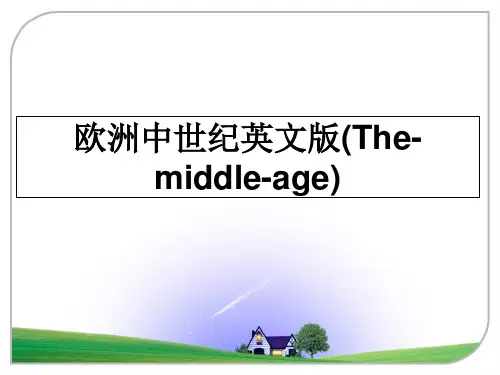
英美文学各个时期主要作家及作品原文中世纪第一篇:英美文学各个时期主要作家及作品原文中世纪英美文学各个时期主要作家及作品原文/节选之中世纪文学(自己整理的)时间:1066年诺曼征服—14世纪下半叶这个时期可以分为2部分,中世纪早期,即1066—17世纪中叶,因为宗教压迫,没有文学作品出现,是文学荒漠;而到了14世纪下半叶,英国文学才开始兴盛起来。
代表人物:杰弗里-乔叟、威廉-兰格伦、约翰-高厄代表作品:《高文爵士与他的绿衣骑士》(约翰-高厄);《坎特伯雷故事集》(杰弗里-乔叟)《农夫皮尔斯》(威廉-兰格伦)特点:这一时期,民间通俗文学占重要位置,展现当时人们的各种生活。
但创作上有失新颖。
此外还大量反映中世纪基督教的教义,表现人类自救。
中世纪盛行的文学形式还有骑士抒情诗。
这种诗歌以叙述性的韵文或者散文歌颂骑士的冒险以及其它的英雄事迹。
主题常常是寻找妖怪、解救美女。
最为著名的代表人物是乔叟,他从法国文学之中引进了各种压尾韵的诗章,取代了古英诗之中的头韵(如《贝尔武弗》)。
在《坎特伯雷故事集》中他运用了英雄双行体(关于英雄双行体我将在以后后的贴子之中介绍)。
这在这个英国文学史上都是首创。
在这一作品之中,他将诗歌艺术进一步向戏剧和小说靠拢。
他是英诗之父。
以下是英美文学界三位大师的介绍和《坎特伯雷故事集》介绍;《农夫皮尔斯》节选;《高文爵士与他的绿衣骑士》节选中世纪文学(一)概述古英语文学英格兰岛的早期居民凯尔特人和其他部族,没有留下书面文学作品。
5世纪时,原住北欧的三个日耳曼部族——盎格鲁、撒克逊和朱特——侵入英国。
他们的史诗《贝奥武甫》传了下来。
诗中的英雄贝奥武甫杀巨魔、斗毒龙,并在征服这些自然界恶势力的过程中为民捐躯。
它的背景和情节是北欧的,单掺有基督教成分,显示出史诗曾几经修改,已非原貌。
按照保存在一部10世纪的手抄本里的版本来看,诗的结构完整,写法生动,所有的头韵、重读字和代称体现了古英语诗歌的特色。